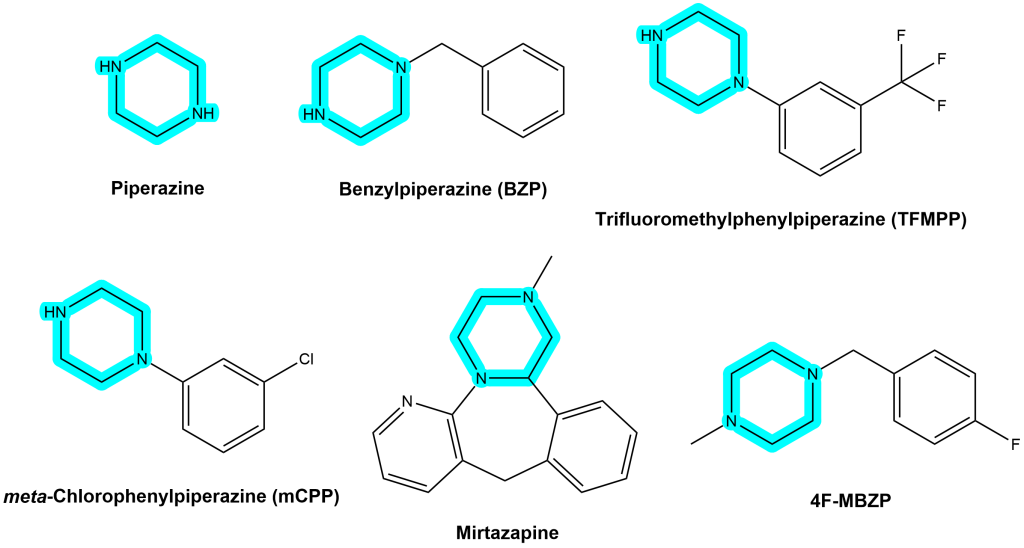
Safer Using – Alpha-PVP
About α-PVP or “Flakka” α-PVP (pronounced alpha-PVP, short for alpha-PyrrolidinoValeroPhenone, also known as flakka, gravel, grind, the zombie drug, or…
Piperazine derivatives (also called piperazines) are a class of drugs which are related to piperazine, a chemical used to manufacture industrial materials.1 Piperazine itself is not psychoactive, but many piperazine derivatives are.1 Several psychoactive piperazines are sold as party drugs or incorrectly sold to users as MDMA.2 They are often sold in pills containing multiple piperazines, but are sometimes sold separately.2 Piperazines are prevalent in Europe, but are also increasingly being detected in the USA, UK, and New Zealand.2 Novel synthetic drugs like piperazines are often called “research chemicals” (RCs) or “designer drugs”. RCs, including piperazines, have very little research into their safety and effects on humans.

The most common piperazine drugs are divided into two classes: benzylpiperazines—which includes BZP (N-benzylpiperazine or simply benzylpiperazine) and MDBP—and phenylpiperazines—which includes TFMPP (trifluoromethylphenylpiperazine) and mCPP (meta-chlorophenylpiperazine).2 Benzylpiperazines tend to act as amphetamine-like stimulants due to their activity on the dopamine system in the brain.2 Phenylpiperazines tend to interact more with the serotonin system, and some even have mild hallucinogenic effects.2 BZP and TFMPP are commonly sold together as a substitute for MDMA, since they act as a stimulant with mild hallucinogenic and empathogenic effects when taken together.2
Piperazines have been found in various pills sold to users as “ecstasy”, “frenzy”, “charge”, “herbal ecstasy”, “A2”, “legal X” or “legal E”.2 Occasionally piperazines are incorrectly sold to users as MDMA, and have also been found as adulterants in MDMA as well as cocaine.2 If you suspect your drugs may be adulterated or contain a different substance entirely, consider testing it with a DIY kit (e.g., https://dancesafe.org/product/mdma-testing-kit/ and/or https://dancesafe.org/product/cocaine-testing-kit/) or by taking it to a drug checking service such as CanTEST.
There are many other piperazines drugs with a wide range of psychoactive effects. Researchers at CanTEST, Canberra’s fixed-site health and drug checking service, discovered a new piperazine derivative called 1-(4-fluorobenzyl)-4-methylpiperazine (4F-MBZP), which was sold to a user as methoxetamine (MXE).3 As a benzylpiperazine, 4F-MBZP possibly has stimulant effects, but its exact effects and toxicity are impossible to predict in humans. Small changes to chemical structures can greatly change the toxicity and subjective effects of substances. Mirtazapine (sold under the brand names Axit, Avanza, Rameron, and others), an antidepressant drug, is also a piperazine derivative.4
BZP puts strain on the heart and increases the risk of seizures, so people with a heart condition or epilepsy should avoid BZP.2
The exact effects of recreational drugs can vary from person to person. The effects of piperazines also depend on the exact type or combination ingested.
Generally, the effects of benzylpiperazines tend to be similar to amphetamines, whereas the effects of phenylpiperazines tend to be somewhat similar to MDMA.2
Commonly, people who take benzylpiperazines, particularly BZP, experience:2
BZP can take a while to kick in (up to 2 hours).5 The effects of BZP typically last 6 to 8 hours.5
In contrast, people who take phenylpiperazines, particularly TFMPP and mCPP, can experience a range of effects including:2,6,7
mCPP can take up to an hour to kick in, and the effects typically last 3-5 hours.6
BZP and TFMPP are commonly taken together.2 The effects of the two drugs in combination tend to be stronger than each drug individually, and tend to more closely mimic the effects of MDMA with some slight dissociation.2 The effects of taking BZP and TFMPP together can include:2
People can react differently to drugs due to differences in bodyweight, metabolism, and other factors. It is always better to start with a low dose and wait before redosing recreational drugs (start low and go slow).
A typical dose of BZP ranges from 50 to 250 mg, and a typical dose of mCPP ranges from 20 to 150 mg.5,6
BZP and TFMPP are generally taken in combination at a roughly 2:1 ratio.2,5 The most common dosages are 100 mg BZP alongside 30 to 50 mg TFMPP.5 It is difficult to dose BZP and TFMPP correctly since a slight overdose carries a risk of seizures.8
The side effects and dangers of overdosing piperazines depend on the type and combination ingested. Mixing drugs can have dangerous and unpredictable effects. No deaths have been reported resulting from a piperazine overdose alone, but one person has died from combining BZP and MDMA.7
If someone falls unconscious while on piperazines, place them in the recovery position and seek medical attention. If you are concerned or someone experiences chest pain on piperazines, seek medical attention.
The symptoms of a BZP overdose can include:2,7,9
A BZP overdose carries a risk of seizures, especially when combined with other stimulants (including TFMPP and MDMA), anticholinergic drugs, or tramadol.2,6
In contrast an overdose on TFMPP or mCPP can cause the following symptoms:2,7
Phenylpiperazines like TFMPP and mCPP trigger the release of serotonin in the brain.2 Serotonin syndrome is a potentially life-threatening condition resulting from too much serotonin in the brain.10 Taking phenylpiperazines alongside another serotonin-releasing drug, such as MDMA, DXM, tramadol or some antidepressants, greatly increases the risk of serotonin syndrome.10 The symptoms of serotonin syndrome include:10
If someone is experiencing the symptoms of a piperazine overdose, consider seeking medical attention and wait with them until they recover. If you are concerned or their condition deteriorates, seek medical attention. The long-term toxicity of piperazines has not been widely studied in humans. mCPP actually appears to be less neurotoxic than MDMA.2 However, some research has suggested that piperazines are toxic to heart, liver and kidney cells.2,5 Severe cases of BZP overdose have resulted in kidney failure and kidney toxicity.2 Piperazines may also interfere with hormone signalling.5
[1] https://en.wikipedia.org/wiki/Piperazine
[2] https://doi.org/10.1016/j.drugalcdep.2011.10.007
[3] https://doi.org/10.1002/dta.3637
[4] https://www.drugs.com/monograph/mirtazapine.html
[5] https://doi.org/10.2478/acph-2020-0035
[6] https://psychonautwiki.org/wiki/MCPP
[7] https://doi.org/10.3109/15563650.2011.615318
[8] https://doi.org/10.1038/sj.npp.1300585
[9] https://www.ncbi.nlm.nih.gov/books/NBK430757/
[10] https://doi.org/10.1056/NEJMra041867
Written by Darcy Lynch

About α-PVP or “Flakka” α-PVP (pronounced alpha-PVP, short for alpha-PyrrolidinoValeroPhenone, also known as flakka, gravel, grind, the zombie drug, or…

About Cocaine Cocaine (also known as benzoylmethylecgonine, coke, cola, snow, ski, blow, white, lello etc.) is a stimulant drug extracted…

About Ketamine Ketamine (also known as ket, K, special K, or horse tranquiliser) is a dissociative anaesthetic belonging to a…